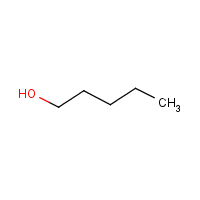1-Pentanol
Agent Name
1-Pentanol
CAS Number
71-41-0
Formula
C5-H12-O
Major Category
Solvents

Synonyms
1-Pentyl alcohol; Alcool amylique [French]; Amyl alcohol; Amyl alcohol (natural); Amyl alcohol, normal; Amylol; Butyl carbinol; Butylcarbinol; N-Amyl alcohol; Pentanol; Pentanol (VAN); Pentanol-1; Pentasol; Pentyl alcohol; Petan-1-ol; Primary amyl alcohol; n-Amyl alcohol; n-Amylalkohol [Czech]; n-Butylcarbinol; n-Pentan-1-ol; n-Pentyl alcohol; [ChemIDplus] UN1105
Category
Alcohols (<C12)
Description
Colorless liquid; [Hawley]
Sources/Uses
Used as a solvent (resins, gums, petroleum additives, synthetic flavors, hydraulic fluids), intermediate, lubricant, ore-flotation agent, plasticizer, corrosion inhibitor, and antioxidant; [HSDB] Occurs naturally in many foods; [CHEMINFO]
Comments
A skin, eye, and respiratory tract irritant; Inhalation of high concentrations can cause CNS depression; [ICSC] Vapor can cause lacrimation, but no significant corneal injury; [HSDB]
Biomedical References
Exposure Assessment
MAK
20 ppm
Vapor Pressure
2.2 mm Hg
Odor Threshold Low
0.12 ppm
Odor Threshold High
20.03 ppm
Lethal Concentration
LCLo (rat) = 14,000 mg/m3/6h
Explanatory Notes
Flash point = 38 deg C; [Merck Index] Odor threshold low = 0.4332 mg/m3; Odor high = 72.2 mg/m3; [HSDB] The Guide in the Emergency Response Guidebook is for "Pentanols." VP from ChemIDplus;
NFPA
may ignite at ambient temp
WEEL
100 ppm
Adverse Effects
Lachrymator
Yes
Neurotoxin
Acute solvent syndrome
Diseases, Processes, and Activities Linked to This Agent
Diseases
Occupational diseases associated with exposure to this agent:
Processes
Industrial Processes with risk of exposure: